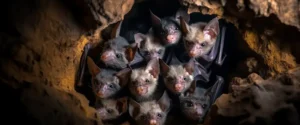Bats in Connecticut
Bats have long been associated with Halloween, and this has fostered many myths about them. They may look spooky to some, but they perform critical tasks in the environment that help humans.
The 1,400 species that are spread across six different continents serve an important purpose in our ecosystem. They pollinate plants, distribute seeds, and control insect pests, including mosquitoes. In the state of Connecticut, there are nine species of bats, and are often categorized into one of two general groups; cave bats or tree-roosting bats.

Cave Bats
Much more is known about cave bats because they tend to live more social and communal lives throughout the year. Cave bats include the big brown bat, which is the species most likely to roost around your home or in your barn in warmer months. Come winter, big browns and the other cave bats, like tri-colored, northern long-eared, eastern small-footed, little brown, and Indiana bats, migrate regionally to cavernous spaces, usually below ground, where they hibernate through the coldest months of the year. Bats select slightly different types of cave-like structures for hibernation, as long as the environmental conditions suit their needs. Most often, they are found hibernating in abandoned mines, caves, and other underground structures, where temperatures hold steady between 32°F and 49°F. During hibernation, the body temperature of a bat can decline from a normal summer range of 99°-106°F down to as low as 32°F. This drop in body temperature helps slow down a bat’s metabolism, reducing its need to eat for several months.
Tree-Roosting Bats
Connecticut’s three tree-roosting bat species include the eastern red, silver-haired, and hoary bats. These species are mostly solitary throughout the year, and do not hibernate in cave-like environments, making them much more difficult to study. Tree-roosting bats generally migrate long distances to more southern latitudes during winter. Upon arrival to their winter range, many tree bats will still hibernate during periods of cold weather, emerging to feed during periods of warm winter weather.
While considered safe from the effects of WNS, migratory tree bats are still facing threats. Habitat loss and mortality associated with wind turbines present other conservation challenges.
Did You Know?
Check out these amazing facts from Bat Conservation International:
- Bats are mammals that belong to the order Chiroptera, which is from the Greek words Cheir (hand) and Pteron (wing)
- On average, most bats can eat up to half their body weight in insects per night
- Bats are the only mammals capable of true flight
- Most species give birth to only one pup per year, making bats some of the slowest reproducing mammals for their size
- Bats are the primary pollinators for agave plants in the wild. They help pollinate many other types of plants from deserts to rainforests by picking up and depositing pollen as they feed on nectar
Bat Hike
This October, come learn more about bats by joining us for an evening hike on October 12th from 6-8pm at Komlo Preserve in New Fairfield! We will discuss the important role bats play in our environment, in addition to the type of habitat they need to survive in Connecticut. We will explore potential conservation actions that you can do in your own backyard to help bats. You will see how scientists “listen” to the bats and the high-tech equipment they use while investigating them. Remember to dress for the weather and bring a flashlight. Sign up here.